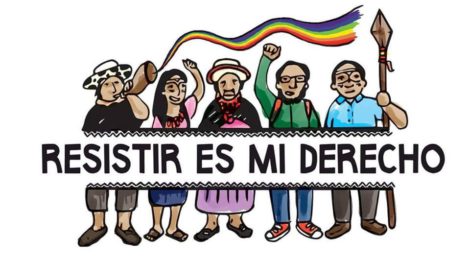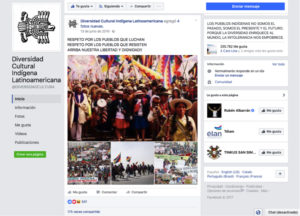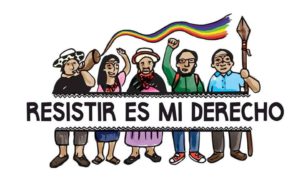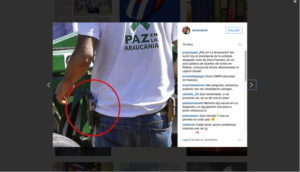
Representing Latin American Indigeneity Online
Today, Mediático is delighted to present an inaugural post by Phoebe Cashman, recent graduate of the University of Leeds with a degree in Spanish, Latin American, Portuguese and German Studies. She is currently working as an English language assistant in Bilbao and plans to do a research MA on the topic she explores here, the representation of indigeneity online, as well as travel to Latin American to work with indigenous groups on the preservation of their language and culture.
Though cyberspace is often dominated by the West it is by no means restricted to it. The increase in accessibility of the Internet to Latin American indigenous populations affords a new means of self-representation that allows them to assert their identity via a digital platform and to reach new consituencies. Indigenous identity can be manifested in many different ways on the Internet; in my analysis of some of these manifestations I’ve been exploring whether the person behind the computer screen identifies as indigenous or is acting on behalf of an indigenous group, and what kind of impact identification might have on the representation of indigenous people’s lives. One of the most significant examples of online representation of indigeneity I stumbled upon in my research is on social media sites Facebook and Twitter.
On Facebook I discovered a page named “Diversidad Cultural Indígena Latinoamericana” (“Latin American Indigenous Cultural Diversity”). Here, the platform has been appropriated by an anonymous group in Buenos Aires (that neither assumes nor denies indigenous identity) and used as a digital arena for cultural preservation in which indigenous customs and traditions are exhibited to a wide audience of users. Regular images uploaded to the page’s wall show photos of groups of men, women and children in traditional dress, alongside gifs of cartoon indigenous girls (reminiscent of Disney’s Pocahontas), indigenous recipes, YouTube videos of indigenous musicians, as well as some articles about indigenous political struggles and some powerful images of nature and landscapes with slogans such as “No somos de derecha ni izquierda, somos de la tierra!” (“We are neither from the left nor the right, we are from the earth”) and “Resistir es mi derecho” (“To resist is my right”). The page conveys a very indigenous-positive attitude, that aims to encourage the public’s appreciation of indigenous lifestyle as well as uphold a strong sense of activism, evident in the page’s description, “Los pueblos indígenas no somos el pasado, somos el presente y el futuro. Porque la diversidad enriquece al mundo, la intolerancia nos empobrece.” (Indigenous peoples are not the past, but the present and future. Because diversity enriches the world and intolerance empoverishes us all”)

Diversidad cultural indígena Latinoamericana’s Facebook page
Despite the page’s attempts at promoting indigenous groups and raising awareness, the exaggerated representation of the stereotypical indigenous identity exemplified by the images on show potentially reduces the intended revolutionary charge of these posts. Although reaching what appears to be a very large, primarily Latin American audience (it has over 272k likes and over 6k currently talking about it), highlighting numerous different aspects of indigenous culture and presenting powerful, politically driven messages, it is hard to gauge if indigenous identity is empowered as a result of this online activity or if it is actually further cemented into a position of social subordination, feeding mainstream ‘Western’ views and expectations of indigenous people by performing stereotypical indigeneity in this way. As a result, indigenous culture and values risk becoming reinforced by the grid of control[1] that the Internet imposes, allowing little room for social change nor the possibility of shedding the skin of marginality that indigenous peoples find themselves involuntarily wearing.

An image posted on Diversidad cultural indígena Facebook page
My second discovery was the Twitter account of Pedro Cayuqueo (@pcayuqueo), an internationally renowned Mapuche journalist from Southern Chile. Some of his most significant achievements involve writing a book about the leader of the Mapuche community Francisco Huenchumilla, writing for the ‘Voces’ section of La Tercera’s blog portal and directing the Kulmapu documentary TV series broadcasted on CNN, which is the first series about the Mapuche community to be broadcasted– he is also a keen Instagramer, demonstrating an overall strong presence on social media. His Twitter feed has most followers with a figure of 60.8k who appear to be from a variety of nationalities. His tweets largely encompass politically charged statements and criticism of the Chilean government, as well as articles on incidents of injustice experienced by the Mapuche community and other more general cultural happenings among the Mapuche community.

Often appearing in photos wearing nothing fancier than shirt and jeans, at a glance one wouldn’t expect Cayuqueo to be of indigenous descent. In this way, Cayuqueo subverts the ‘Western’ view of indigenous peoples by way of refusal to visibly perform the indigeneity expected of him, in other words, he doesn’t wear traditional indigenous dress or face paint, and so on, while openly and proudly defining himself as indigenous, having said to La Tercera online “Soy un mapuche originalmente puro”. As a result of this visual subversion, the stereotypical view of indigeneity is challenged. Cayuqueo could represent one of the first successful indigenous people to strive for the rights and welfare of indigenous people having achieved such a strong presence on social media, especially Twitter, and having reached large numbers of Twitter users internationally, but could it be because of his decision to appear less indigenous that he has become so successful?
Overall, both examples exhibit greatly differing approaches with respect to their “virtual face of indignity”[2]; the group from Buenos Aires working on Facebook focusing more on diffusing and protecting indigenous cultural values via the publication of images overtly expressing indigenous culture, and Cayuqueo on Twitter using a more verbal approach (digitally speaking) to focus on expressing his political opinion and striving for political change, however without visually identifying himself with traditional indigenous culture.
The risks for Latin American indigenous groups of stepping into the domain of the Internet are unavoidable. On the one hand they run the risk of their identity becoming fragmented and ‘Westernised’ once out in Cyberspace, which could ultimately lead to the loss of their identity’s core elements: primarily their traditions, culture and lifestyle. On the other hand, they risk reaffirming their identity on a digital platform to the extent that they also reaffirm their socio-political position of subordination, both on and offline. Neither option is particularly desirable or controllable. With this in mind, Cayuqueo’s approach brings a question to light: when striving for equality among indigenous groups, is it necessary to detach oneself visually from one’s roots and appear more ‘Western’ in order to gain respect and recognition nationally and internationally, or even just to catch and hold the eye of a Westerner, or anyone? But then in failing to perform the visual indigeneity expected of him, is the validity of his opinion and even of his identity reduced? Would this mean that ‘Diversidad Cultural Indígena Latinoamericana’ has a more valid virtual face of indigeneity because it performs the ‘correct’ indigeneity, that is, the indigeneity expected of it?
Bibliography:
- Landzelius, Kyra, ed., Native on the Net (Oxon: Routledge, 2006)
- Nakamura, Lisa, Race After the Internet (New York: Routledge, 2012)
Notes:
[1] Kyra Landzelius, Native on the Net (Oxon: Routledge, 2006)
[2] Lisa Nakamura, Race After the Internet (New York: Routledge, 2012) p.219






